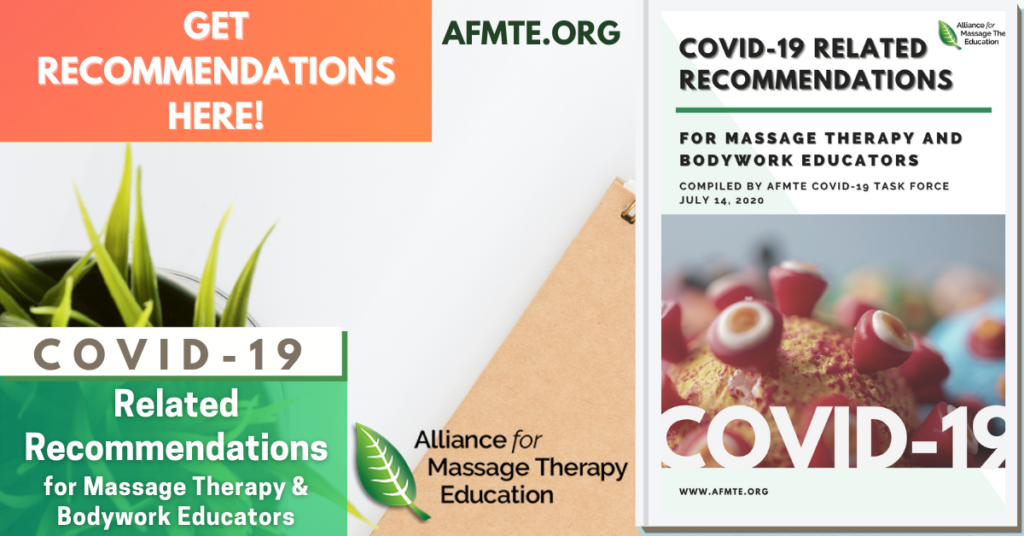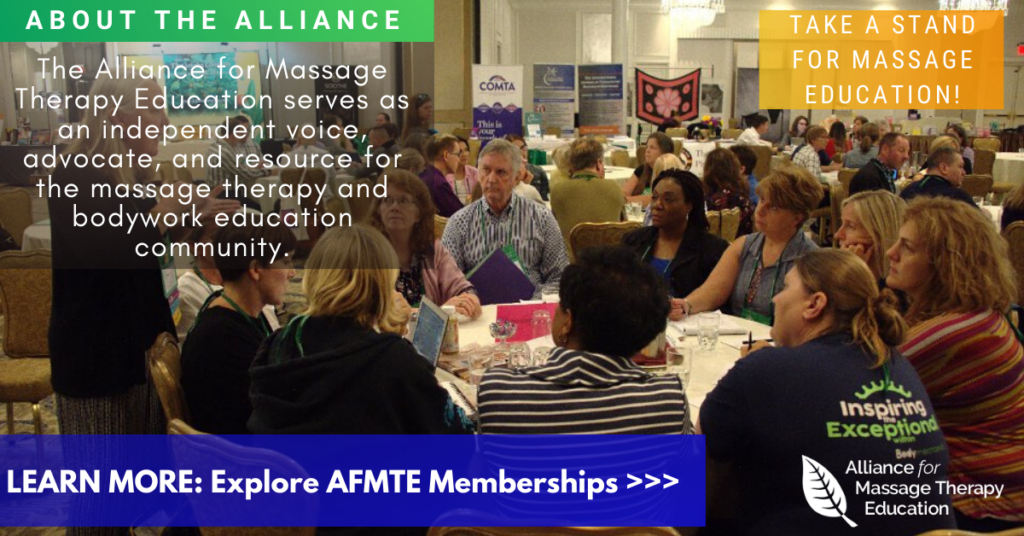
COVID-19 Related Recommendations for Massage Therapy and Bodywork Educators
ACCESS THE PDF-VERSION HERE (opens in a new tab)
In May 2020 the Alliance for Massage Therapy Education (AFMTE) formed a task force to explore COVID-19 recommendations or guidelines to assist educators in maintaining/returning to high quality education, both in schools and in continuing education. Guidelines and regulations have been prepared for the professional practice of massage and bodywork. Institutions of higher education are preparing guidelines for students, faculty, and staff. Comparatively massage and bodywork education is unique. Programs are in place at community colleges, vocational and career schools, private institutions, and in residential settings. Continuing education courses are held in a range of sites including conference centers and hotels. Existing guidelines left some gaps that this project sought to address. The aim is to help massage and bodywork educators and administrators think through the many considerations for successful teaching and learning in the COVID-19 era.
Content analysis was used to identify areas of concern and solutions related to teaching and learning in general, and for specific needs of massage and bodywork. Data sources used to gather information include: resources aimed at general higher education (professional publications, general news, a sampling of websites), informal interviews with sources in health professions education, as well as articles specific to the massage and bodywork profession. Insights were also obtained from presentations and questions during the AFMTE-hosted webinar series sessions held between mid-March and June 2020. Key areas of concern in the didactic and clinical/hands on areas of the curriculum as well as continuing education were identified. These concerns were written statements for consideration and were clustered under general headings. Task force members reviewed, commented, and suggested revisions to each consideration. This information was used to prepare an initial draft of the guidelines that was sent to reviewers for comment and feedback. Information provided was used to revise the document which was submitted to the AFMTE Board of Directors for review and approval.
This document was developed to supplement any state or local regulations, as well as recommendations from broader scientific, occupational, professional, educational, or accrediting organizations, related to delivery of massage or involving educational activities.
Keep in mind, these recommendations are not mandated regulations for educators. They are intended to assist educators in thinking through the many new facets of teaching in a virtual and socially distanced environment. They will be interpreted by each educator with consideration for their particular institutional needs and requirements, local regulation, and more.
Massage Therapy Schools:
Safety/PPE
- Hold a safety meeting upon resuming face-to-face education and require attendance for all faculty, staff, and students prior to return to class. Review policies and procedures.
- Require PPE for faculty, staff, and students in accordance with local regulations.
Academic Integrity
- Review academic integrity policy to ensure that it covers changes to instructional methods and update if needed. Policy should be reviewed with all students when updated.
Visitors, Guests, and Personal Items
- Minimize external visitors to the facility. Establish screening procedures (such as those recommended by the CDC), traffic patterns, and PPE to maintain social distancing in accordance with local requirements.
- Request that faculty, staff, and students minimize items carried into the facility. Ensure that bags, books, coats, clothing, umbrellas, and other personal items are contained to avoid accidental touching or use.
Scheduling
- Modify course, clinic, and staff schedules to reduce the number of people in facilities to accommodate social distancing in accordance with state and regional regulations. For students and faculty, this may include use of distance learning or hybrid distance/face-to-face learning. For clinic this may include alterations in clinic schedules and hours. For staff this may include virtual work or flexible hours.
- Plan for return to face-to-face learning with flexibility. This may include optional workshops to aid students in the integration of didactic course material with techniques and soft deadlines for assignment submissions. Prepare for the possibility of future local or regional quarantine.
Curriculum Changes
- Review courses and curricula to ensure that any changes or alterations provide adequate coverage of material. Communicate any changes to appropriate institutional committees, accreditation bodies, and boards prior to implementation of any changes.
Accommodations
- Ensure adequate instructional support is available for students with disabilities, English language learners, and any student who has fallen behind. Additional support and possible accommodations for distance learning may be needed for students experiencing unease about returning to in-person classes.
Student Support
- Post in a prominent area contact information for mental health support services for faculty, staff, or students who may have difficulty coping with economic strain, grief, or return to school.
Didactic Courses
- Minimize contact by offering courses via distance learning formats, using high quality instructional methods to engage students.
- Provide students with supplemental resources and optional materials to help master course content. This may include study guides, access to peer tutoring, and/or links to supplementary course material.
- Utilize a range of low stakes assessments for ongoing monitoring of student progress and identifying needs for remediation (if applicable.)
- Any student(s) exposed to COVID-19 who is required to self-quarantine should be offered opportunities for distance learning to make-up course activities until able to return to class.
- Maintain an ongoing commitment to quality teaching and learning by course and curriculum assessment to identify content where students could benefit from supplemental instruction or resources and providing access to tutoring or resource material.
Hands On Courses
- Configure classrooms and teaching areas in accordance with hygiene and safety recommendations.
- Incorporate formal or informal competency-based rubrics to assess and document student performance progress.
- Follow recommendations for handling and transporting linens.
- Follow recommendations for dedicated clothing during hands-on practice and transport of used clothing after class.
- Create quality learning and practice opportunities for students to make up missed coursework.
- Pause between instructor demonstration and student practice to allow adequate cleaning time.
- Instructors should avoid casual demonstrations of techniques during exchange classes and wash hands before and after touching any student.
- If schools opt to have students wear gloves, ensure proper performance of gloved massage, and provide supplementary instruction on hand/wrist health.
- If schools opt to have students wear gloves when performing massage, plan for future instructional sessions on modalities that use hands and forearms.
- For clothed bodywork modalities, students and instructors should change clothing before and after each practice session. Worn clothing should be bagged to transport home for cleaning.
- Provide supplemental resources (e.g. videos, photos, drawings, written treatment protocols) for students to review demonstration of massage and bodywork techniques.
- Within the bounds of institutional and local regulations, work to provide opportunities for advanced students to have adequate practice of massage to refine techniques, work on body mechanics, and build endurance. This may include independent practice, live or recorded video of techniques, and debriefing with the instructor.
Clinic and Practicum
- Continue ongoing screening of students and clients for possible exposure and symptoms.
- Incorporate formal or informal competency-based rubrics to assess and document student performance progress.
- Survey major massage employers about PPE and practice requirements for content to include or review in the curriculum to ensure students are adequately prepared.
- Postpone or delay externships in areas where social distancing is in place.
- Create quality learning and practice opportunities for students to make up missed coursework.
- If clothed modalities are performed, students and clients should change clothing before and after the session. Worn clothing should be bagged to transport home for cleaning.
- Consider best use of distance learning vs. face to face time to facilitate “catching up” without overwhelming students with hands-on time. Provide optional supplemental activities to aid students in integration of didactic course material (i.e. anatomy, physiology, pathophysiology, kinesiology) with practice of massage and bodywork techniques.
For Continuing Education Providers
Scheduling and Screening of Participants
- Postpone hands-on courses in any state or locality where social distancing is in place until social distancing is no longer mandated. For the safety of all participants, registrants from states/localities where social distancing is in place should not attend face-to-face courses in other locations.
- Prior to start of course, screen registrants in accordance with requirements of the state/locality where the class will take place about exposure to COVID-19, requirements to self-quarantine, and symptoms. Excuse from the course anyone who has knowingly been exposed, is required to self-quarantine, or is symptomatic.
Facilities and Requirements for Participation
- Hold courses in facilities with adequate hygiene and social distancing capabilities.
- Limit hands-on courses to facilities that can be thoroughly cleaned before and after each practice session, as well as at the beginning and end of each day.
- Require students and instructors to follow local and CDC hygiene recommendations for PPE, clothing, handling of linens, and use of equipment.
Alternate Formats
- Develop courses that emphasize cognitive and affective learning domains to provide professionals with educational opportunities in areas where social distancing is in place. Kinesthetic/practical work should not be performed where social distancing is in place if an alternative format can be utilized.
Demonstration and Practice
- Instructors should avoid casual demonstrations of techniques (such as showing a correction of a stroke, modeling body mechanics, or illustrating a variation of a touch technique) without taking time to thoroughly wash hands before and after touching any participant.
- Where possible, have attendees work with the same partner for the duration of the course to minimize contact.
Suggested Resources
Centers for Disease Control and Prevention. Coronavirus (COVID-19), 2020, https://www.cdc.gov/coronavirus/2019-ncov/index.html.
The Chronicle of Higher Education. Here’s a List of Colleges’ Plans for Reopening in the Fall, 2020, https://www.chronicle.com/article/Here-s-a-List-of-Colleges-/248626?cid=wcontentgrid_hp_1b.
FSMTB. Massage and Bodywork Guidelines for Practice with COVID-19 Considerations, Federation of State Massage Therapy Boards, 2020, https://www.fsmtb.org/media/2319/fsmtb20200519guidelinesforpracticecovid-19.pdf. PDF download.
InsideHigherEd www.insidehighered.com
Local public health departments where a school is located or a continuing education activity is planned to be held.
NASPA: Student Affairs Administrators in Higher Education www.naspa.org
World Health Organization www.who.int
United States Department of Education www.ed.gov
Website for the state board where a school is located or a continuing education activity is planned to be held.
Contributors
Lurana Bain, LMT -Elgin, IL
Virginia Cowen, PhD, LMT, BCTMB- Tappan, NY
Joe Lubow, BS, LMT, BCTMB – Sarasota, FL
Sandy Mason, BA, LMBT, LMT, BCTMB, CMBE – Pinnacle, NC
Gayle McDonald, MS, LMT – Portland, OR
Michele Renee, DC, MAc, MT – Minneapolis, MN
Spring Saldana, BA, LMT – Bloomington, MN
Reviewers
Larry Ball, LMBT – Winston-Salem, NC
Jane Garofano, PhD, N.C.T.M.B, LMT – Tuxedo Park, NY
Dale Healey, DC, PhD – Bloomington, MN
Katy Lundell-Stuhr, DC, MT – Willmar, MN
Donna Sarvello, MBA, LMT, BCTMB – Bolingbrook, IL
AFMTE Board of Directors
Stan Dawson, DC, President – Acworth, GA
Michele Renee, DC, MAc, MT, Vice President – Minneapolis, MN
Dawn Hogue, MA, LMT, Secretary – Virginia Beach, VA
Sandy Mason, BA, LMBT, LMT, BCTMB, CMBE, Treasurer – Pinnacle, NC
MK Brennan, MS, RN, MT (ret), Director – Charlotte, NC
Randy Clark, BS, LMT, CNMT, Director – Clearwater, FL
Virginia Cowen, PhD, LMT, BCTMB, Director – Tappan, NY
Gini Ohlson, Director – Evanston, IL
Jodi Scholes, LMT, Director – Portsmouth, NH
The AFMTE is a member-based organization, and your support really matters! Click here to learn more about AFMTE memberships

